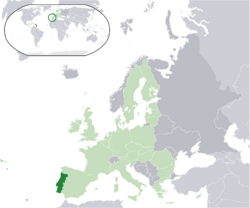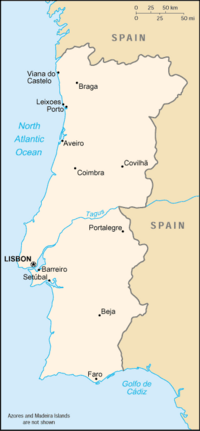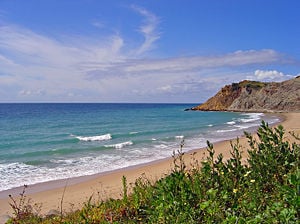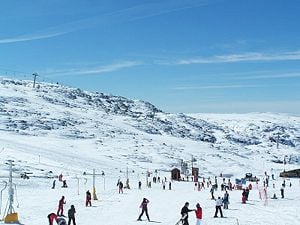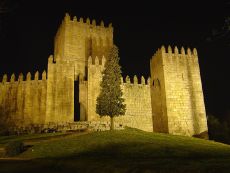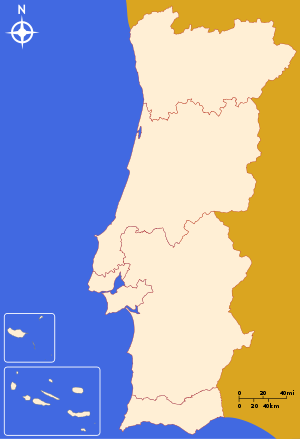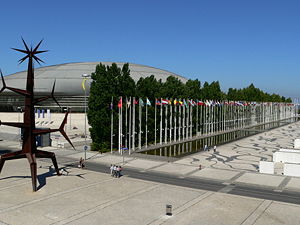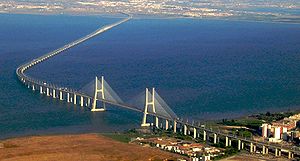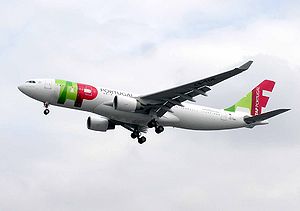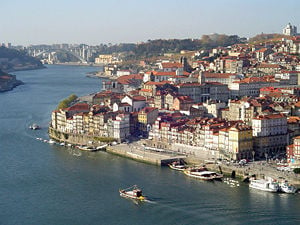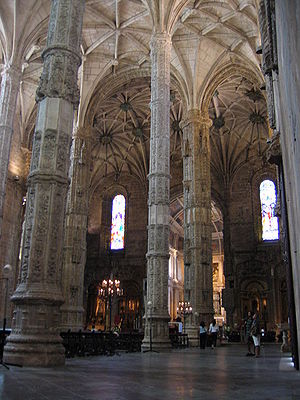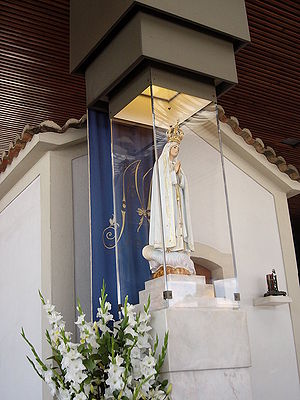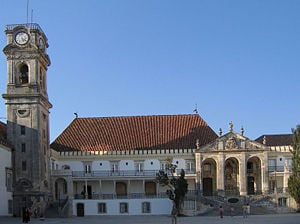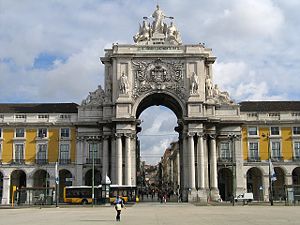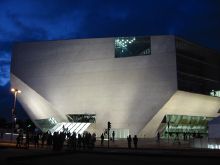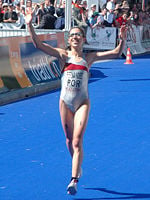Difference between revisions of "Portugal" - New World Encyclopedia
Mike Butler (talk | contribs) |
Mike Butler (talk | contribs) |
||
| Line 272: | Line 272: | ||
==Culture== | ==Culture== | ||
| − | + | [[Image:Roman temple, Evora, Alentejo, Portugal, 28 September 2005.jpg|thumb|left|300px|Roman temple, Évora.]] | |
| − | [[Image:Roman temple, Evora, Alentejo, Portugal, 28 September 2005.jpg| | + | [[Image:Torre de Belém1.JPG|thumb|left|300px|[[Belém Tower]], built in the 1510s and a symbol of the [[Age of Discovery]], [[Lisbon]]]] |
| − | + | [[Image:ArcoDoTriunfoLisboa1.JPG|thumb|left|300px|Praça do Comércio with the arch leading to Augusta street, in Lisbon.]] | |
| − | [[Image:Torre de Belém1.JPG|thumb|left| | + | [[Image:Fundacao Calouste Gulbenkian Lisboa.JPG|thumb|left|300px|The Calouste Gulbenkian Foundation, [[Lisbon]].]] |
| + | The culture of Portugal is rooted in the [[Latin]] culture of [[Ancient Rome]], with a [[Celtiberians|Celtiberian]] background (a mixture of pre-Roman [[Celts]] and [[Iberians]]). Portugal has a rich traditional [[folklore]] (''Ranchos Folclóricos''), with great regional variety. Many towns have a museum and a collection of ancient monuments and buildings. Many places have at least a cinema, some venues to listen to music and locations to see arts and crafts. | ||
===Architecture=== | ===Architecture=== | ||
| + | Since the second millennium B.C.E., the area where [[Portugal]] is situated today has been the location of important construction. Built before the arrival of the [[Roman]]s, [[Citânia de Briteiros]] in [[Guimarães]] is a good example of native architecture. The houses were round, built from granite without mortar, in settlements (''[[Castro culture|castro]]s'') in the mountains, and were surrounded by protective walls. | ||
| + | |||
| + | Portuguese architecture developed significantly with the arrival of the Romans (in the [[second century B.C.E.]]), and evolved towards other architecture around the Mediterranean. [[Ancient Rome|The Romans]] built aqueducts, bridges and roads, along with theatres, temples, circuses and other public buildings. There are particular ruins of buildings made by the Romans, called ''Centum Cellas'' whose purpose has yet to be discovered. | ||
| + | |||
| + | Portugal boasts several scores of medieval castles, as well as the ruins of several villas and forts from the period of Roman occupation. [[Romanesque]] and [[Gothic]] influences have given Portugal some of its greatest cathedrals, and in the sixteenth century a national style (''[[Arte Manuelina]]'') was synthesized by adapting several forms into a luxuriantly ornamented whole. | ||
| + | |||
| + | Restoration architecture (1640-1717), the Baroque style (1717-1755), the Pombaline style (1755-1780), a secular, utilitarian architecture marked by [[pragmatism]] was used after the [[1755 Lisbon earthquake]] and the subsequent tsunami and fires destroyed many buildings in [[Lisbon]]. | ||
| + | |||
| + | One of the top architecture schools in the world, known as "Escola do Porto" or School of [[Porto]], is located in Portugal. Its alumni include [[Álvaro Siza]] (winner of a [[Pritzker Prize|Pritzker]] prize) and [[Eduardo Souto de Moura]]. | ||
| + | |||
| + | ''Azulejos'', glazed ceramic tiles that cover the facades and interiors of churches, government buildings, and private homes, characterize Portuguese architecture. Azulejos, introduced by the Moors, use both geometric and representational patterns. | ||
| + | |||
| + | Traditional peasant houses in the north, often have two stories and a red tubular clay tile roof, and were built with thick granite walls, and verandas. The south commonly had one-story, whitewashed, flat-roofed houses with blue trim around the windows and doorways, built to keep out the summer heat. | ||
===Art=== | ===Art=== | ||
| − | + | ||
The 20th century saw the arrival of [[Modernism]], and along with it came the most prominent Portuguese painters: [[Amadeo de Souza-Cardoso]], who was heavily influenced by French painters, particularly by the [[Delaunays]]. Among his best known works is ''Canção Popular a Russa e o Fígaro''. Another great modernist painter/writer was [[Almada Negreiros]], friend to the poet [[Fernando Pessoa]], who painted his (Pessoa’s) portrait. He was deeply influenced by both [[Cubist]] and [[Futurism (art)|Futurist]] trends. Prominent international figures in visual arts nowadays include painters [[Vieira da Silva]], [[Júlio Pomar]], and [[Paula Rego]]. | The 20th century saw the arrival of [[Modernism]], and along with it came the most prominent Portuguese painters: [[Amadeo de Souza-Cardoso]], who was heavily influenced by French painters, particularly by the [[Delaunays]]. Among his best known works is ''Canção Popular a Russa e o Fígaro''. Another great modernist painter/writer was [[Almada Negreiros]], friend to the poet [[Fernando Pessoa]], who painted his (Pessoa’s) portrait. He was deeply influenced by both [[Cubist]] and [[Futurism (art)|Futurist]] trends. Prominent international figures in visual arts nowadays include painters [[Vieira da Silva]], [[Júlio Pomar]], and [[Paula Rego]]. | ||
Traditional architecture is distinctive. Modern Portugal has given the world renowned architects like [[Eduardo Souto de Moura]], [[Álvaro Siza Vieira]] and [[Gonçalo Byrne]]. Internally, [[Tomás Taveira]] is also noteworthy. | Traditional architecture is distinctive. Modern Portugal has given the world renowned architects like [[Eduardo Souto de Moura]], [[Álvaro Siza Vieira]] and [[Gonçalo Byrne]]. Internally, [[Tomás Taveira]] is also noteworthy. | ||
| Line 287: | Line 301: | ||
===Cuisine=== | ===Cuisine=== | ||
| − | |||
[[Image:Pasteis.jpg|thumb|right|''[[Pastéis de Nata]]'' (cream custards)]] | [[Image:Pasteis.jpg|thumb|right|''[[Pastéis de Nata]]'' (cream custards)]] | ||
{{main|Portuguese Cuisine|Portuguese Wine}} | {{main|Portuguese Cuisine|Portuguese Wine}} | ||
Revision as of 04:09, 9 November 2007
| República Portuguesa Portuguese Republic | |||||
| |||||
| Anthem: "A Portuguesa" | |||||
| Capital | Lisbon5 38°46′N 9°11′W | ||||
|---|---|---|---|---|---|
| Largest city | capital | ||||
| Official languages | Portuguese1 | ||||
| Government | Parliamentary democracy | ||||
| - President | Aníbal Cavaco Silva | ||||
| - Prime Minister | José Sócrates | ||||
| Formation | June 24 1128 | ||||
| - Founding of the First County of Portugal | 868 | ||||
| - Battle of São Mamede | June 24 1128 | ||||
| - Kingdom | 25 July 1139 | ||||
| - Recognized | 5 October 1143 | ||||
| - Republic | 5 October 1910 | ||||
| - Carnation Revolution | 25 April 1974 | ||||
| Accession to EU | 1 January 1986 | ||||
| Area | |||||
| - Total | 92,345 km² (110th) 35,580 sq mi | ||||
| - Water (%) | 0.5 | ||||
| Population | |||||
| - July 2007 estimate | 10,848,692 | ||||
| - 2001 census | 10,148,259 | ||||
| - Density | 114/km² 295/sq mi | ||||
| GDP (PPP) | 2006 estimate | ||||
| - Total | $229.881 billion | ||||
| - Per capita | $23,464 (2007) | ||||
| HDI (2006) | |||||
| Currency | Euro (€)² (EUR)
| ||||
| Time zone | WET³ (UTC) | ||||
| - Summer (DST) | WEST (UTC0) | ||||
| Internet TLD | .pt4 | ||||
| Calling code | +351 | ||||
Portugal, officially the Portuguese Republic, is a country in southwestern Europe, on the Iberian Peninsula.
The land within the borders of today's Portuguese Republic has been constantly settled since prehistoric times. The Moors occupied most of the Iberian Peninsula from the early 8th century when they first arrived and conquered the Christian Kingdoms of Germanic background. After the starting of the Reconquista, in the early 1100s Portugal appeared as a kingdom independent of its Christian neighbours, Castile and Leon. In little over a century Portugal had nearly established its modern-day borders by conquering territory from the Muslim Moors.
During the 15th and 16th centuries, with its global empire which included possessions in Africa, Asia and South America, Portugal was one of the world's major economic, political, and cultural powers. In the 19th century, armed conflict with French and Spanish invading forces at mainland, and the loss of its largest territorial possession abroad, Brazil, which declared independence unilaterally, disrupted political stability and potential economic growth. After the Carnation Revolution's coup d'état in 1974, its regimen was deposed in Lisbon and the country lost its last overseas provinces in Africa.
Portugal is a developed country, and although having the lowest GDP per capita of all Western European countries, it has a high Human Development Index and one of the highest quality of life ratings in the world. It is a member of the European Union (since 1986) and the United Nations (since 1955); as well as a founding member of the European Union's Eurozone, OECD, NATO, and CPLP (Comunidade dos Países de Língua Portuguesa — Community of Portuguese Language Countries).
Geography
Being the westernmost country of mainland Europe, Portugal is bordered by the Atlantic Ocean to the west and south and by Spain to the north and east. The Atlantic archipelagos of the Azores and Madeira are also part of Portugal.
Portugal is not a large country — the total land area is 35,580 square miles (92,345 square kilometers) or slightly smaller than Indiana in the United States. Mainland Portugal is split by its main river, the Tagus. The northern landscape comprises the mountainous border of the Meseta, the ancient rock core of the Iberian Peninsula, with plateaus indented by river valleys. The south, between the Tagus and the Algarve (the Alentejo), features mostly rolling plains.
Portugal's highest point is Mount Pico on Pico Island. It is an ancient volcano measuring 7713 feet (2351 meters). Mainland Portugal's highest point is Serra da Estrela, measuring 6558 feet) (1993 meters).
The climate can be classified as Oceanic in the north and Mediterranean in the south. Portugal is one of the warmest European countries, the annual temperature averages in mainland Portugal are 55°F (13°C) in the north and 64°F (18°C) in the south. The Madeira and Azores Atlantic archipelagos have a narrower temperature range. Generally, spring and summer are sunny, whereas autumn and winter are rainy and windy. Extreme temperatures occur in northeastern parts of the country in winter (where they may fall to -16°C) and Southeastern parts in summer (where they can soar up to 46°C). Sea coastal areas are milder, temperatures varying between -2°C in the coldest winter mornings and 37°C in the hottest summer afternoons. Absolute extremes registered so far have been -23°C in Serra da Estrela and 48°C in the Alentejo region.
The south has a climate somewhat warmer and drier than in the cooler and rainier north. The Algarve, separated from the Alentejo by mountains, enjoys a Mediterranean climate much like southern Spain. Snow falls occasionally (on some cold winter days) in the northern interior of the country, from October to May. However, it is a very rare event in the south. The coast registers snow usually once in five or six years.
Portugal's major rivers, the Douro, Tagus (Rio Tejo), and Guadiana, flow from the central Meseta before draining west to the Atlantic. The Guadiana flows south.
The plants and animals of Portugal are a mixture of Atlantic, or European, and Mediterranean (with some African) species. North of the Mondego valley, 57 percent of the plants are European species (more than 86 percent in the northern interior), and only 26 percent Mediterranean; in the south the proportions are 29 and 46 percent, respectively.
As in Spain, the wild goat, wild pig and deer are found in the Portuguese countryside. The Wolf survives in the remote parts of Serra da Estrela, the Lynx in Alentejo, while the fox, rabbit and Iberian hare are everwhere. Birds abound because the peninsula lies on the winter migration route of western and central European species. Fish are plentiful, especially the European sardine. Crustaceans are common on the northern rocky coasts.
Natural resources include fish, forests (cork), iron ore, copper, zinc, tin, tungsten, silver, gold, uranium, marble, clay, gypsum, salt, arable land, hydropower
Portugal's Exclusive Economic Zone, a seazone over which the Portuguese have special rights over the exploration and use of marine resources, has 1,727,408 km². This is the 3rd largest Exclusive Economic Zone of the European Union and the 11th in the world.
The Azores is subject to severe earthquakes. Environmental issues include soil erosion, air pollution caused by industrial and vehicle emissions, and water pollution, especially in coastal areas.
Conservation areas of Portugal include one national park (Parque Nacional), 12 natural parks (Parque Natural), 9 natural reserves (Reserva Natural), 5 natural monuments (Monumento Natural), and 7 protected landscapes (Paisagem Protegida), ranging from the Parque Nacional da Peneda-Gerês to the Parque Natural da Serra da Estrela to the Paul de Arzila.
Lisbon is the capital and largest city of Portugal. Its municipality, which matches the city proper excluding the larger continuous conurbation, has a municipal population of 564,477, although the Lisbon Metropolitan Area in total has around 2.8 million inhabitants, and 3.34 million people live in the broader agglomeration of Lisbon Metropolitan Region (includes cities ranging from Leiria to Setúbal). Other metropolitan areas are Porto, Braga, Coimbra, Setúbal and Aveiro.
History
--- from intro Some of the earliest civilizations include Celtic societies, followed by incorporation into the Roman Republic dominions in the 2nd century B.C.E., and subsequently into Germanic Kingdoms, such as the Suebi and the Visigoths, from the 5th to the 8th century. ---
The early history of Portugal, whose name probably derives from the Roman name Portus Cale, is shared with the rest of the Iberian peninsula. The region was settled by Pre-Celts and Celts, giving origin to peoples like the Lusitanians, visited by Phoenicians and Carthaginians, incorporated in the Roman Republic dominions (as Lusitania in 138 B.C.E.), settled again by Suevi, Buri, and Visigoths, and conquered by Moors. In 868, during the Reconquista (by which Christians reconquered the Iberian peninsula from the Muslim and Moorish domination), the First County of Portugal was formed. A victory over the Muslims at Ourique in 1139 is traditionally taken as the occasion when Portugal is transformed from a county into an independent kingdom.
Portugal traces its national origin to June 24 1128 with the Battle of São Mamede. At the Battle of São Mamede, Afonso Henriques, Count of Portugal, defeated his mother, Countess Teresa, and her lover, Fernão Peres de Trava, in battle - thereby establishing himself as sole leader. Afonso Henriques proclaimed himself king of Portugal on July 25, 1139, after the Battle of Ourique and was recognized as such in 1143 by Afonso VII, king of León and Castile, and in 1179 by Pope Alexander III.
Afonso Henriques and his successors, aided by military monastic orders, pushed southward to drive out the Moors, as the size of Portugal covered about half of its present area. In 1249, this Reconquista ended with the capture of the Algarve on the southern coast, giving Portugal its present day borders, with minor exceptions.
In 1373, Portugal made an alliance with England, which is the longest-standing alliance in the world.
In 1383, the king of Castile, husband of the daughter of the Portuguese king who had died without a male heir, claimed his throne. An ensuing popular revolt led to the 1383-1385 Crisis. A faction of petty noblemen and commoners, led by John of Aviz (later John I), seconded by General Nuno Álvares Pereira defeated the Castilians in the Battle of Aljubarrota. This celebrated battle is still a symbol of glory and the struggle for independence from neighboring Spain.
In the following decades, Portugal spearheaded the exploration of the world and undertook the Age of Discovery. Prince Henry the Navigator, son of King João I, became the main sponsor and patron of this endeavor.
In 1415, Portugal gained the first of its overseas colonies when a fleet conquered Ceuta, a prosperous Islamic trade center in North Africa. There followed the first discoveries in the Atlantic: Madeira and the Azores, which led to the first colonization movements.
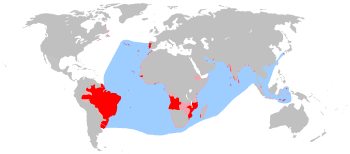
Throughout the 15th century, Portuguese explorers sailed the coast of Africa, establishing trading posts for slaves and gold as they looked for a route to India and its spices, which were coveted in Europe. In 1498, Vasco da Gama finally reached India and brought economic prosperity to Portugal and its then population of one million residents.
In 1500, Pedro Álvares Cabral, en route to India, discovered Brazil and claimed it for Portugal.[1] Ten years later, Afonso de Albuquerque conquered Goa, in India, Ormuz in the Persian Strait, and Malacca in what is now a state in Malaysia. Thus, the Portuguese empire held dominion over commerce in the Indian Ocean and South Atlantic. It may also have been Portuguese sailors that were the first Europeans to discover Australia.[2]
Portugal's independence was interrupted between 1580 and 1640. Because the heirless King Sebastian died in battle in Morocco, Philip II of Spain claimed his throne and so became Philip I of Portugal. Although Portugal did not lose its formal independence, it was governed by the same monarch who governed Spain, briefly forming a union of kingdoms; in 1640, John IV spearheaded an uprising backed by disgruntled nobles and was proclaimed king. This was the beginning of the House of Braganza, which was to reign until 1910. On 1 November 1755, Lisbon, the largest city and capital of the Portuguese Empire, was strongly shaken by an earthquake which killed between 60,000 and 90,000 people and destroyed eighty-five percent of the city.
By this time, however, the Portuguese empire was already under attack from other countries, specifically Britain and the Netherlands. Portugal began a slow but inexorable decline until the 20th century. This decline was hastened by the independence in 1822 of the country's largest colonial possession, Brazil.

At the height of European colonialism in the 19th century, Portugal had lost its territory in South America and all but a few bases in Asia. During this phase, Portuguese colonialism focused on expanding its outposts in Africa into nation-sized territories to compete with other European powers there. Portuguese territories eventually included the modern nations of Cape Verde, São Tomé and Príncipe, Guinea-Bissau, Angola, and Mozambique.
In 1910, a revolution deposed the Portuguese monarchy, but chaos continued and considerable economic problems were aggravated by the military intervention in the First World War, which led to a military coup d'état in 1926. This in turn led to the establishment of a right-wing dictatorship by António de Oliveira Salazar.
In December 1961, the Portuguese army was involved in armed action in its colony of Portuguese India against an Indian invasion. The operations resulted in the defeat of the isolated and relatively small Portuguese defense force which was not able to resist a much larger enemy. The outcome was the loss of the Portuguese territories in the Indian subcontinent.
Also in the early 1960s, independence movements in the Portuguese overseas provinces of Angola, Mozambique, and Portuguese Guinea, in Africa, resulted in the Portuguese Colonial War (1961-1974). In 1974, a bloodless left-wing military coup in Lisbon, known as the Carnation Revolution, led the way for a modern democracy as well as the independence of the last colonies in Africa shortly after.
Portugal joined the European Union in 1986, and ever since it has engaged in a process of convergence with its EU counterparts.
Government and politics
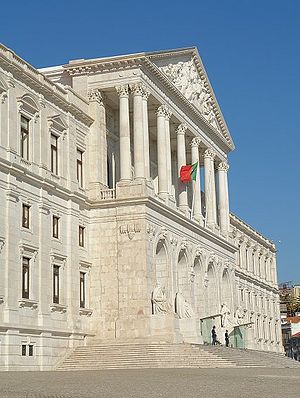
Constitutional structure
The politics of Portugal take place in a framework of a parliamentary representative democratic republic, as defined by ruled by the Portuguese Constitution of 1976, whichgrants the separation of powers among legislative, executive, and judicial branches. The president, who is chief of state and is directly elected to a five-year term, appoints the prime minister and council of ministers, according to assembly election results. There is also a council of state, which is a presidential advisory body composed of six senior civilian officers. The unicameral assembly of the republic (Assembleia da Republica) has 230 members who are elected by popular vote to serve four-year terms. Following legislative elections, the leader of the majority party or majority coalition is usually appointed prime minister by the president. Suffrage is universal to those aged 18 years of age and over.
The courts are organized into categories, including judicial, administrative, and fiscal. The supreme courts are the courts of last appeal. A thirteen-member constitutional court oversees the constitutionality of legislation. The judiciary consists of a supreme court (Supremo Tribunal de Justica), to which judges appointed for life by the Conselho Superior da Magistratura, as well as a series of other courts to serve the different levels of justice.
The Portuguese legal system is part of the civil law legal system, also called the continental family legal system. Until the end of the nineteenth century, French law was the main influence. Since then the major influence has been German law. The Constitutional Tribunal reviews the constitutionality of legislation. Portugal accepts accepts compulsory International Court of Justice jurisdiction with reservations.
The national and regional governments, and the Portuguese parliament, are dominated by two political parties, the Socialist Party and the Social Democratic Party. Minority parties CDU (Portuguese Communist Party plus Ecologist Party "The Greens"), Bloco de Esquerda (Left Bloc) and CDS-PP (People's Party) are also represented in the parliament and local governments.
Foreign relations
The foreign relations of Portugal are linked with its historical role as a key player in the Age of Discovery and the holder of the now defunct Portuguese Empire. Portugal is an European Union member state and an ally of NATO. The country could be defined as a committed proponent of European integration and transatlantic relations. Notable modern day successes include the role it played in achieving the independence of its former colony of East-Timor as well as several fruitful Presidencies of the European Union. Historically the focus of Portuguese diplomacy has been to preserve its independence vis-à-vis the danger of annexation by Spain and the maintenance of the Anglo-Portuguese Alliance which came into being in 1294 and, with the United Kingdom as successor to England, which is still in place today.
The only international dispute concerns the municipality of Olivença (Olivenza in Spanish). Under Portuguese sovereignty since 1297, the municipality of Olivença was ceded to Spain under the Treaty of Badajoz in 1801, after the War of the Oranges. Portugal claimed it back in 1815 under the Treaty of Vienna. Nevertheless, bilateral diplomatic relations between the two neighbouring countries are cordial, as well as within the European Union.
Military of Portugal
The armed forces have three branches: Army, Navy, and Air Force. The military of Portugal serves primarily as a self-defense force whose mission is to protect the territorial integrity of the country and providing humanitarian assistance and security at home and abroad. Since the early 2000s, compulsory military service is no longer practised. The changes also turned the forces' focus towards professional military engagements. The age for voluntary recruitment is set at 18. In the twentieth century, Portugal engaged in two major military interventions: the First Great War and the Colonial War (1961-1974). Portugal has participated in peacekeeping missions in East Timor, Bosnia, Kosovo, Afghanistan, Iraq (Nasiriyah), and Lebanon.
Administrative divisions
Portugal has an administrative structure of 308 municipalities (Portuguese singular/plural: concelho/concelhos), which are subdivided into more than 4,000 parishes (freguesia/freguesias). Municipalities are grouped for administrative purposes into superior units. For continental Portugal the municipalities are gathered in 18 Districts, while the Islands have a Regional Government directly above them. Thus, the largest unit of classification is the one established since 1976 into either mainland Portugal (Portugal Continental) or the autonomous regions of Portugal (Azores and Madeira).
Since 1978, Portugal conceded political autonomy to its archipelagos (Madeira and Azores) due to the great distance from Lisbon. The regional autonomies have Regional Governments that are constituted by the Presidente do Governo Regional (Regional Government President) and by Secretários Regionais (Regional Secretaries).
The Portuguese territory was reorganized in accordance with a system of statistical regions and subregions known as N.U.T.S. (Nomenclature of Territorial Units for Statistics) that are the basis of the statistical system of information for the entire European Union.
Economy
Portugal has become a diversified and increasingly service-based economy since joining the European Community in 1986. Over the past two decades, successive governments have privatized many state-controlled firms and liberalized key areas of the economy, including the financial and telecommunications sectors. Portugal was one of the founding countries of the euro in 1999, and therefore is integrated into the Eurozone.
Major industries include oil refineries, automotive, cement production, pulp and paper industry, textile, footwear, furniture, and cork (of which Portugal is the world's leading producer). Agriculture and Fishing (see Portugal EEZ) no longer represents the bulk of the economy, but Portuguese wines, namely Port Wine (named after the country's second largest city, Porto) and Madeira Wine (named after Madeira Island), are exported worldwide. Tourism is also important, especially in mainland Portugal's southernmost region of the Algarve and in the Atlantic Madeira archipelago.
Economic growth had been above the EU average for much of the 1990s, but fell back in 2001-06. GDP per capita stands at roughly two-thirds of the EU-25 average, at $23,464 — a rank of 34th out of 194 countries. A poor educational system, in particular, has been an obstacle to greater productivity and growth.
The Global Competitiveness Report for 2005, published by the World Economic Forum, places Portugal on the 22nd position, ahead of countries like Spain, Ireland, France, Belgium and Hong Kong. This represents an increase of two places from the 2004 ranking. Portugal was ranked 20th on the Technology index and 15th on the Public Institutions index.
Research about standard of living by the Economist Intelligence Unit's (EIU) Quality-of-life Survey places Portugal as the country with the 19th-best quality of life in the world, ahead of other economically and technologically advanced countries like France, Germany, the United Kingdom and South Korea.
Caixa Geral de Depósitos, EDP, Galp, Millennium bcp, Portugal Telecom and Sonae are among the largest corporations of Portugal by both number of employees and net income. The major stock exchange is the Euronext Lisbon which is part of the NYSE Euronext, the first global stock exchange. The PSI-20 is Portugal's most selective and widely known stock index.
In 2006, the world's largest solar power plant began operating in the nation's sunny south while the world's first commercial wave power farm opened in October 2006 in the Norte region. As of 2006, 55 percent of electricity production was from coal and fuel power plants. The other 40 percent was produced by hydroelectrics and five percent by wind energy. The government was channeling $3.8-billion into developing renewable energy sources over the subsequent five years.
Transportation was seen as a priority in the 1990s, pushed by the growing use of automobiles and industrialization. The country has a 42,708 mile (68,732km) network of roads, of which almost 1864 miles (3000km) are part of a 44 motorway system.
The two principal metropolitan areas have subway systems: Lisbon Metro and Metro Sul do Tejo in Lisbon Metropolitan Area and Porto Metro in Porto, each with more than 35 km (22 mi) of lines. Construction of a high-speed TGV line connecting Porto with Lisbon and Lisbon with Madrid will begin in 2008; it will replace the Pendolinos.
Lisbon's geographical position makes it a stopover point for many foreign airlines. The most important airports are in Lisbon, Faro, Porto, Funchal (Madeira), and Ponta Delgada (Azores).
Portugal has one of the highest mobile phone penetration rates in the world (the number of operative mobile phones already exceeds the population). This network also provides wireless mobile Internet connections as well, and covers the entire territory. As of October 2006, 36.8 percent of households had high-speed Internet services and 78 percent of companies had Internet access.
Exports totalled $43.58-billion in 2006. Export commodities included clothing and footwear, machinery, chemicals, cork and paper products, and hides. Export partners included Spain 26.5 percent, Germany 12.9 percent, France 12 percent, UK 6.7 percent, US 6.1 percent.
Imports totalled $64.45-billion in 2006. Import commodities included machinery and transport equipment, chemicals, petroleum, textiles, agricultural products. Import partners included Spain 29 percent, Germany 13.1 percent, France 8.1 percent, Italy 5.6 percent, and the Netherlands 4.4 percent.
The unemployment rate was 7.6 percent in 2006.
Demographics
Population
As of 2007 Portugal has 10,848,692 inhabitants of whom about 418,000 were legal immigrants. Portugal, long a country of emigration, has now become a country of net immigration, and not just from the former Indian and African colonies; by the end of 2003, legal immigrants represented about five percent of the population, and the largest communities were from Brazil, Ukraine, Romania, Cape Verde, Angola, Russia, Guinea-Bissau and Moldova with other immigrants from parts of Latin America, China and Eastern Europe. Life expectancy at birth in 2007 was total population was 77.87 years.
Ethnicity
Portugal's population has been remarkably homogeneous, helping it become the first unified nation-state in Western Europe. For centuries Portugal had virtually no ethnic, tribal, racial, religious, or cultural minorities. Native Portuguese are ethnically a combination of pre-Roman Celts along with some other minor contributions by Romans, Germanic (Visigoths, Suebi), Jews and Moors (mostly Berbers and some Arabs). Citizens of black African descent who immigrated to the mainland during decolonization number fewer than 100,000, and since 1990 East Europeans have entered Portugal.
The recently-arrived population of immigrants, from former colonies in Africa and Asia, are residentially segregated in Lisbon neighborhoods with poor housing, even though anti-racism laws prohibit and penalize racial discrimination in housing, business, and health services.
Religion
Portugal like most European countries has no state religion, making it a secular state. The great majority of the Portuguese population (84 percent) belongs to the Roman Catholic Church, but only about 19 percent attend mass and take the sacraments regularly. A larger number wish to be baptized, married in the church, and receive last rites. Religious observance remains somewhat strong in northern areas, with the population of Lisbon and southern areas generally less devout.
Religious minorities include a little over 300,000 Protestants. There are also about 50,000 Muslims and 10,000 Hindus. Most of them came from Goa, a former Portuguese colony on the west coast of India (Some Muslims also came from former Portuguese African colonies with important Muslim minorities: Guinea-Bissau, Mozambique, and São Tomé and Príncipe). There are also about 1,000 Jews. Portugal is also home to less than 10,000 Buddhists, mostly Chinese from Macau and a few Indians from Goa.
There are between 420,960 to 947,160 (4 to 9 percent of total population) atheists and agnostics.
Although church and state were formally separated during the Portuguese First Republic (1910-26), a separation reiterated in the constitution of 1976, Catholic precepts continue to have an important weight in the Portuguese society. Many Portuguese holidays and festivals have religious origins. The educational and health care systems were for a long time the church's preserve, and many times when a building, bridge, or highway is opened, it receives the blessing of the clergy.
The practice of religion in Portugal showed striking regional differences. Even in the early 1990s, 60 to 70 percent of the population in the traditionally Roman Catholic north regularly attended religious services, compared with 10 to 15 percent in the historically anticlerical south. In the greater Lisbon area, about 30 percent were regular churchgoers.
The most famous of Portuguese religious events was the supposed apparition of the Virgin Mary to three children in 1917 in the village of Fátima in the province of Santarém. Hundreds of thousands of pilgrims have visited the shrine at Fátima in the belief that the pilgrimage could bring about healing.
Language
Portuguese, the official language, is a Romance language that originated in what is now Galicia (Spain) and northern Portugal from the Latin spoken by romanized Celts about 1000 years ago. It spread worldwide in the fifteenth and sixteenth centuries as Portugal established a colonial and commercial empire which spanned from Brazil in the Americas to Goa in India and Macau in China. During that time, many creole languages based on Portuguese also appeared around the world, especially in Africa, Asia and the Caribbean.
Today it is one of the world's major languages, ranked sixth according to number of native speakers (over 200 million). It is the language with the largest number of speakers in South America (188 million, over 51 percent of the continent's population), and also a major lingua franca in Africa. It is the official language of nine countries.
Mirandese language, another Romance language, is sparsely spoken in a small area of northeastern Portugal, in the Miranda do Douro municipality. The Portuguese Parliament granted it co-official recognition (along with Portuguese language) for local matters.
Men and women
The 1976 constitution outlawed discrimination by sex, and divorce and abortion became legal. Women have outpaced men in higher education, and Portugal has had one woman serve as president. However, women still perform the major domestic chores, although more men are involved in child care.
Marriage and the family
Illegitimacy remains high in rural northern Portugal. Households in the north tend to consist of a three-generation family, wheras in the south households are generally composed of a nuclear family. In the north, the married couple heads the household, wheras among urban middle-class and in the south, the dominant male is head of the household.
Education
Education is a subject of controversy due to its complexities and state of flux. There are also concerns related to the large dropout rates (mostly in the secondary and higher education systems), the high multi-generational functional illiteracy (48 percent = ~ 5,100,000 functional illiterates) and illiteracy rates (7.5 percent = ~ 800,000 illiterates), which is a quite mediocre statistical record when compared with other developed countries. The education system of Portugal is regulated by the State through the Ministry of Education, and the Ministry of Science and Technology and Higher Education. The public education system is the most popular and well established, but there are also many private schools at all levels of education.
Pre-primary education is optional from the ages of three to five, and is provided in both state-run and private nursery schools. Basic education lasts for nine years from age six and is divided into three stages of four, two and three years respectively. A Diploma/Certificate is awarded at the end of the third stage.
Secondary education - public, private and cooperative - is compulsory and consists of a three-year cycle after basic education. Access is through the Certificate of Basic Education. There are two types of courses: general courses and technical/vocational courses, providing instruction in technical, technological, professional fields, and in the Portuguese language and culture.
Higher education in Portugal is divided into two main subsystems: university and polytechnic education, and it is provided in autonomous public universities, private universities, public or private polytechnic institutions and higher education institutions of other types. The university system has a strong theoretical basis and is highly research-oriented; the non-university system provides a more practical training and is profession-oriented.
Portuguese universities have existed since 1290. Scientific and technological research activities in Portugal are mainly conducted within a network of R&D units belonging to public universities and state-managed autonomous research institutions like the INETI - Instituto Nacional de Engenharia, Tecnologia e Inovação.
Class
At the end of the Second World War, Portugal had a small upper class, a small middle class, a small urban working class, and a mass of rural peasants. There was little social mobility, and a distinction was made between those who worked with their hands and those who did not. The rural south had a massive population of landless day laborers which enabled the Communist Party to grow strong in the south after the 1974 "revolution." The 1976 constitution defined Portugal as a republic engaged in the formation of a classless society. Since then, Portugal has become less socially rigid, and education is an avenue to social mobility. The middle class has grown and the peasant population has declined, but a gap remains between the social, economic, and political elites from the bulk of the population.
Culture
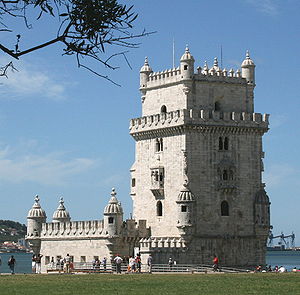

The culture of Portugal is rooted in the Latin culture of Ancient Rome, with a Celtiberian background (a mixture of pre-Roman Celts and Iberians). Portugal has a rich traditional folklore (Ranchos Folclóricos), with great regional variety. Many towns have a museum and a collection of ancient monuments and buildings. Many places have at least a cinema, some venues to listen to music and locations to see arts and crafts.
Architecture
Since the second millennium B.C.E., the area where Portugal is situated today has been the location of important construction. Built before the arrival of the Romans, Citânia de Briteiros in Guimarães is a good example of native architecture. The houses were round, built from granite without mortar, in settlements (castros) in the mountains, and were surrounded by protective walls.
Portuguese architecture developed significantly with the arrival of the Romans (in the second century B.C.E.), and evolved towards other architecture around the Mediterranean. The Romans built aqueducts, bridges and roads, along with theatres, temples, circuses and other public buildings. There are particular ruins of buildings made by the Romans, called Centum Cellas whose purpose has yet to be discovered.
Portugal boasts several scores of medieval castles, as well as the ruins of several villas and forts from the period of Roman occupation. Romanesque and Gothic influences have given Portugal some of its greatest cathedrals, and in the sixteenth century a national style (Arte Manuelina) was synthesized by adapting several forms into a luxuriantly ornamented whole.
Restoration architecture (1640-1717), the Baroque style (1717-1755), the Pombaline style (1755-1780), a secular, utilitarian architecture marked by pragmatism was used after the 1755 Lisbon earthquake and the subsequent tsunami and fires destroyed many buildings in Lisbon.
One of the top architecture schools in the world, known as "Escola do Porto" or School of Porto, is located in Portugal. Its alumni include Álvaro Siza (winner of a Pritzker prize) and Eduardo Souto de Moura.
Azulejos, glazed ceramic tiles that cover the facades and interiors of churches, government buildings, and private homes, characterize Portuguese architecture. Azulejos, introduced by the Moors, use both geometric and representational patterns.
Traditional peasant houses in the north, often have two stories and a red tubular clay tile roof, and were built with thick granite walls, and verandas. The south commonly had one-story, whitewashed, flat-roofed houses with blue trim around the windows and doorways, built to keep out the summer heat.
Art
The 20th century saw the arrival of Modernism, and along with it came the most prominent Portuguese painters: Amadeo de Souza-Cardoso, who was heavily influenced by French painters, particularly by the Delaunays. Among his best known works is Canção Popular a Russa e o Fígaro. Another great modernist painter/writer was Almada Negreiros, friend to the poet Fernando Pessoa, who painted his (Pessoa’s) portrait. He was deeply influenced by both Cubist and Futurist trends. Prominent international figures in visual arts nowadays include painters Vieira da Silva, Júlio Pomar, and Paula Rego. Traditional architecture is distinctive. Modern Portugal has given the world renowned architects like Eduardo Souto de Moura, Álvaro Siza Vieira and Gonçalo Byrne. Internally, Tomás Taveira is also noteworthy.
Since the 1990s, Portugal has increased the number of public cultural facilities, in addition to the Calouste Gulbenkian Foundation established in 1956 in Lisbon. These include the Belém Cultural Center in Lisbon, Serralves Foundation and the Casa da Música, both in Porto, as well as new public cultural facilities like municipal libraries and concert halls which were built or renovated in many municipalities across the country.
Cuisine
Portuguese cuisine is diverse. The Portuguese love dry cod (bacalhau in Portuguese), for which there are hundreds of recipes. Two other popular fish recipes are grilled sardines and caldeirada. Typical Portuguese meat recipes, that may take beef, pork, lamb, or chicken, include feijoada, cozido à portuguesa, frango de churrasco, and carne de porco à alentejana. Typical fast food dishes include the francesinha from Porto, and bifanas (grilled pork), prego (grilled beef) or leitão (piglet) sandwiches which are well known around the country. The Portuguese art of pastry has its origins in ancient recipes of which pastéis de Belém (or pastéis de nata) originally from Lisbon, and ovos-moles from Aveiro are good examples.
Portuguese wines have deserved international recognition since the times of the Roman Empire, which associated Portugal with their God Bacchus. Today the country is known by wine lovers and its wines have won several international prizes. Some of the best Portuguese wines are: Vinho Verde, Vinho Alvarinho, Vinho do Douro, Vinho do Alentejo, Vinho do Dão, Vinho da Bairrada and the sweet: Port Wine, Madeira Wine and the Moscatel from Setúbal and Favaios. Port Wine is well known around the world and the most widely exported Portuguese wine.
Cinema
Literature
Portuguese literature, one of the earliest Western literatures, developed through text and song. Until 1350, the Portuguese-Galician troubadours spread their literary influence to most of the Iberian Peninsula.[3] Gil Vicente (ca. 1465 - ca. 1536), was one of the founders of both Portuguese and Spanish dramatic traditions. Adventurer and poet Luís de Camões (ca. 1524-1580) wrote the epic poem The Lusiads, with Virgil's Aeneid as his main influence. Modern Portuguese poetry is rooted in neoclassic and contemporary styles, as exemplified by Fernando Pessoa (1888–1935). Modern Portuguese literature is represented by authors such as Almeida Garrett, Camilo Castelo Branco, Eça de Queirós, Sophia de Mello Breyner Andresen, and António Lobo Antunes. Particularly popular and distinguished is José Saramago, winner of the 1998 Nobel Prize for literature.
Music
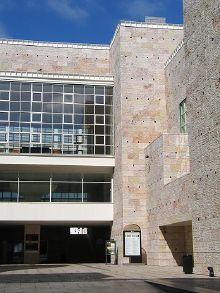
Portuguese music encompasses a wide variety of genres. The most renowned is fado, a melancholy urban music, usually associated with the Portuguese guitar and saudade, or longing. Coimbra fado, a unique type of fado, is also noteworthy. Internationally notable performers include Amália Rodrigues, Carlos Paredes, José Afonso, Mariza, Carlos do Carmo, Mísia, and Madredeus. One of the most notable Portuguese musical groups outside the country, and specially in Germany, is the goth-metal band Moonspell. In addition to fado and folk, the Portuguese listen to pop and other types of modern music, particularly from North America and the British Isles, as well as a wide range of Portuguese and Brazilian artists and bands.[4] Bands with international recognition include Blasted Mechanism and The Gift, both of which were nominated for an MTV Music Award. Portugal has several summer music festivals, such as Festival Sudoeste in Zambujeira do Mar, Festival de Paredes de Coura in Paredes de Coura, Festival Vilar de Mouros near Caminha, and Rock in Rio Lisboa and Super Bock Super Rock in Lisbon. Out of the summer season, Portugal has a large number of festivals, designed more to an urban audience, like Flowfest or Hip Hop Porto. Furthermore, one of the largest international Goa trance festivals takes place in northern Portugal every two years, and the student festivals of Queima das Fitas are major events in a number of cities across Portugal.
It has also a rich history as far as painting is concerned. The first well-known painters date back to the XV century – like Nuno Gonçalves - were part of the Gothic painting period. José Malhoa, known for his work Fado, and Columbano Bordalo Pinheiro (who painted the portraits of Teófilo Braga and Antero de Quental) were both references in naturalist painting.
Sports
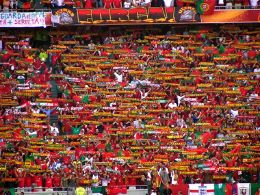
Football is the most known, loved and practiced sport. The legendary Eusébio is still a major symbol of Portuguese football history and Luís Figo and Cristiano Ronaldo are among the numerous examples of other world class footballers born in Portugal and noted worldwide.
The Portuguese national teams, have titles in the FIFA World Youth Championship and in the UEFA youth championships. The main national team - Selecção Nacional - finished second in Euro 2004, and reached the third place in the 1966 FIFA World Cup, their best results in major competitions to date.
S.L. Benfica, F.C. Porto and Sporting C.P. are the largest sports clubs by popularity and in terms of trophies won, often known as "os três grandes" ("the big three"). They have a number of titles won in the European UEFA club competitions, were present in many finals and have been regular contenders in the last stages almost every season. Other than football, many Portuguese sports clubs, including the "big three", compete in several other sports events with a varying level of success and popularity.
Portugal has a successful rink hockey team, with 15 world titles and 20 european titles, making it the country with the most wins in both competitions. The most successful Portuguese rink hockey clubs in the history of European championships are F.C. Porto, S.L. Benfica, Sporting CP, and Óquei de Barcelos.
The national rugby union team made a dramatic qualification into the 2007 Rugby World Cup and become the first all amateur team to qualify for the World Cup since the dawn of the professional era. The Portuguese national team of rugby sevens has performed well, becoming one of the strongest teams in Europe, and proved their status as European champions in several occasions.
Rui Silva, in men's athletics, has won several gold, silver and bronze medals in the European, World and Olympic Games competitions. Francis Obikwelu in the 100 m and the 200 m, had silver in the 2004 Summer Olympics. Naide Gomes in pentathlon and long jump, is another Portuguese elite athlete. In the triathlon, Vanessa Fernandes, has won a large number of medals and major competitions across the world and in 2007 became the world champion both in Triathlon and Duathlon. In judo, Telma Monteiro is European champion in the women's under-52 kg category. Nelson Évora is world champion in triple jump.
Cycling, with Volta a Portugal being the most important race, is also a popular sports event and include professional cycling teams such as S.L. Benfica, Boavista, Clube de Ciclismo de Tavira, and União Ciclista da Maia. Noted Portuguese cyclists include, among others, names as Joaquim Agostinho, Marco Chagas, José Azevedo and Sérgio Paulinho.
The country has also achieved notable performances in sports like fencing, surfing, windsurf, kitesurf, kayaking, sailing and shooting, among other. The paralympic athletes have also conquered many medals in sports like swimming, boccia and wrestling. Portugal has its own original martial art, jogo do pau, in which the fighters use staffs to confront one or several opponents.
International rankings
Political and economic rankings
- Political freedom ratings - Free; political rights and civil liberties both rated 1 (the highest score available)
- Press freedom - 10th freest, at 3.00
- GDP per capita - 34th highest, at I$22,677
- Human Development Index - 28th highest, at 0.904
- Income Equality - 59th most equal, at 38.5 (Gini Index)
- Unemployment rate - 48th lowest, at 7.60%
- Corruption - 25th least corrupt, at 6.6 on index
- Economic Freedom - 30th freest, at 2.29 on index
Health rankings
- Fertility rate- 158th most fertile, at 1.48 per woman
- Birth rate - 159th most births, at 10.72 per 1000 people
- Death rate - 58th highest death rate, at 10.56 per 1000 people
- Life Expectancy - 33rd highest, at 77.87 years
- Suicide Rate - 40th highest suicide rate, at 18.9 for males and 4.9 for females
- HIV/AIDS rate - 73rd most cases, at 0.40%
Other rankings
- Global Peace Index - 9th highest, out of 121 countries
- CO2 emissions - 66th highest emissions, at 5.6 tonnes per capita
- Electricity Consumption - 44th highest consumption of electricity, at 44,010,000,000 kWh
- Broadband uptake - 21st highest uptake in OECD, at 11.5%
- Beer consumption - 20th highest, at 59.6 litres per capita
Facts and figures
- Official date format: YYYY/MM/DD (ex. 2006/09/08)
- Common date format: DD/MM/YYYY (ex. 06/09/2006), dates are written out as DD de MM de YYYY (ex. 18 de Agosto de 2005)
- Decimal separator is a comma: 123,45
- Thousands are officially separated by a space — 10 000 — although the point is still used — 10.000.
- The euro sign is commonly placed either before or after the amount, with the separator either a comma or a point: 10,95 € - € 10,95 - € 10.95 - 10.95 €
ReferencesISBN links support NWE through referral fees
- ↑ The standard view of historians is that Cabral was blown off course as he was navigating the currents of the South Atlantic, sighted the coast of South America, thereby accidentally discovering Brazil. For an account of an alternative view of the discovery of Brazil, however, see Alternative theory of the European discovery of Brazil
- ↑ Map proves Portuguese discovered Australia: new book, in Reuters (Wed Mar 21, 2007)
- ↑ Poesia e Prosa Medievais, p. 9, para. 4
- ↑ Portugese-Top50 stats
- Ribeiro, Ângelo & Saraiva, José Hermano História de Portugal I - A Formação do Território QuidNovi, 2004 (ISBN 989-554-106-6)
- Ribeiro, Ângelo & Saraiva, José Hermano História de Portugal II - A Afirmação do País QuidNovi, 2004 (ISBN 989-554-107-4)
- de Macedo, Newton & Saraiva, José Hermano História de Portugal III - A Epopeia dos Descobrimentos QuidNovi, 2004 (ISBN 989-554-108-2)
- de Macedo, Newton & Saraiva, José Hermano História de Portugal IV - Glória e Declínio do Império QuidNovi, 2004 (ISBN 989-554-109-0)
- Ribeiro, Ângelo & Saraiva, José Hermano História de Portugal V - A Restauração da Indepêndencia QuidNovi, 2004 (ISBN 989-554-110-4)
- Saraiva, José Hermano História de Portugal X - A Terceira República QuidNovi, 2004 (ISBN 989-554-115-5)
- Loução, Paulo Alexandre: Portugal, Terra de Mistérios Ésquilo, 2000 (third edition; ISBN 972-8605-04-8)
- Muñoz, Mauricio Pasto: Viriato, A Luta pela Liberdade Ésquilo, 2003 (third edition; ISBN 972-8605-23-4)
- Grande Enciclopédia Universal Durclub, 2004
- Constituição da República Portuguesa, VI Revisão Constitucional, 2004
- Programa do Movimento das Forças Armadas, 1974 [1]
External links
- Portugal World Fact Book 2007, accessed November 5, 2007.
- Culture of Portugal Countries and their cultures, accessed November 8, 2007.
- (English)(Portuguese) Official Portuguese Government website
- (English) Official Parliament website
- (English) Official Travel and Tourism office website
- (English) Wikitravel guide to Portugal
 Wikimedia Atlas of Portugal, holding maps related to Portugal.
Wikimedia Atlas of Portugal, holding maps related to Portugal.- (English) Portugal in Photography 2007
Albania · Andorra · Armenia2 · Austria · Azerbaijan1 · Belarus · Belgium · Bosnia and Herzegovina · Bulgaria · Croatia · Cyprus2 · Czech Republic · Denmark3 · Estonia · Finland · France3 · Georgia1 · Germany · Greece · Hungary · Iceland · Ireland · Italy · Kazakhstan1 · Latvia · Liechtenstein · Lithuania · Luxembourg · Republic of Macedonia · Malta · Moldova · Monaco · Montenegro · Netherlands3 · Norway3 · Poland · Portugal · Romania · Russia1 · San Marino · Serbia · Slovakia · Slovenia · Spain3 · Sweden · Switzerland · Turkey1 · Ukraine · United Kingdom3 · Vatican City
1 Has majority of its territory in Asia. 2 Entirely in Asia but having socio-political connections with Europe. 3 Has dependencies or similar territories outside Europe.
Credits
New World Encyclopedia writers and editors rewrote and completed the Wikipedia article in accordance with New World Encyclopedia standards. This article abides by terms of the Creative Commons CC-by-sa 3.0 License (CC-by-sa), which may be used and disseminated with proper attribution. Credit is due under the terms of this license that can reference both the New World Encyclopedia contributors and the selfless volunteer contributors of the Wikimedia Foundation. To cite this article click here for a list of acceptable citing formats.The history of earlier contributions by wikipedians is accessible to researchers here:
- Portugal history
- Politics_of_Portugal history
- Economy_of_Portugal history
- Demographics_of_Portugal history
- Religion_in_Portugal history
- Portuguese_language history
- Education_in_Portugal history
- Culture_of_Portugal history
The history of this article since it was imported to New World Encyclopedia:
Note: Some restrictions may apply to use of individual images which are separately licensed.

